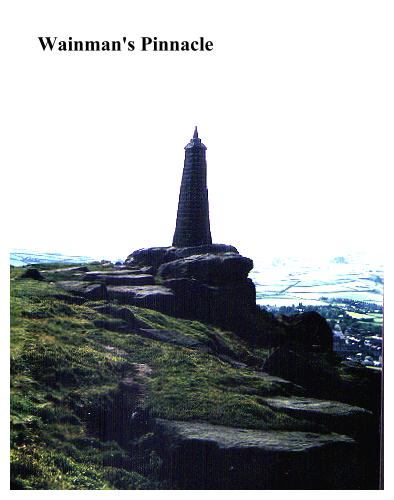
On this walk we visit a stone pinnacle, indulge in a bracing promenade along crags, and ascend a fine prospect tower with extensive views of Upper Airedale. For 'afters' we visit a mysterious moorland boulder with a strange legend attached to it.
Getting there: Follow A629 from Keighley towards Skipton (NOT Aire Valley Trunk Road). At Crosshills bear Left following A6068 Colne Road through Glusburn to Cowling. Just beyond Cowling turn Left up Old Lane which beyond a sharp bend becomes Piper Lane. This leads past Far Place (on Right) to Stake Hill. Park in rough car park beside road, from which an obvious path leads down the wallside to Wainman's Pinnacle.
Distance: 2m Easy. Little more than a stroll.
Map ref: SD 986 426 Maps OS Blackburn & Burnley Sheet 103 1:50,0000, or OS Pathfinder 670 Barnoldswick & Earby Sheet SD 84/94 1:25, 000.
Rating Follies & General Interest *** Walk *

This is the simplest and easiest walk in the book, yet what it lacks in distance it more than makes up for in interest. With two fine follies, magnificent views, and ample scope for a picnic or an exciting rock scramble, Earl Crag is jumble of gritstone rocks with numerous fissures and small caves which invite exploration.
The Earl Crag Monuments have long held for me a special fascination. Unwittingly, at the tender age of seven or eight, I was brought here by my uncle, who sat proudly at the wheel of 'Bluey',his recently acquired Morris 8. In those days a owning a car (any car!) was a luxury, and a 'run out' in Uncle Bill's car, even with the regular breakdowns, was a treat indeed! We parked up on the roadside, visited the tower, (timidly ascending the dark staircase) and then explored the crags, where we picnicked and scrambled amongst the boulders. We picked some heather, decked out Bluey's radiator with a sprig, and then headed for home, stopping for a paddle in Keighley Tarn en route. This was my first visit to the Earl Crag Monuments and I have been in love with them ever since!
Like all follies the Earl Crag Monuments have their share of mystique. No one really seems to know what to call them. My Uncle Bill referred to them as 'Cowling Pinnacles'. Other people confuse the names:- is it Wainman's Tower and Lund's Pinnacle? or Wainman's Pinnacle and Lund's Pinnacle. Here, now and for the record be it known that the Tower is Lund's and the Pinnacle is Wainman's!!
Wainman's Pinnacle stands at a junction of paths on a natural boulder on the edge of Earl Crag, overlooking Carr Head. The view from the pinnacle comes as something of a surprise, as the magnificent prospect across the valley opens up suddenly and quite unexpectedly. In true folly fashion, not much is known about Wainman's Pinnacle. As a result it has become the object of much fanciful yarn spinning. According to one account it was erected by Lady Amcotts, the young wife of one of the Wainmans. She, so the story goes, erected the pinnacle in memory of her much lamented husband who had died fighting for the royalist cause in the Civil Wars. Another account suggests that the pinnacle was erected in 1815 to commemorate Wellington's defeat of Napoleon at the Battle of Waterloo, and that, for my money, is the more likely reason for its construction. One thing we know for sure, is that by the end of the 19th century the pinnacle had been severely damaged by lightning, being subsequently demolished and rebuilt in January 1900 by Messrs. Gott and Riddiough of Cowling. This is the pinnacle which we see today.
The route to Lund's Tower is fine promenade along the grim black rampart of Earl Crag, with excellent views across the Aire Valley to Rombald's Moor. The going is brisk, and the wind is (usually) bracing!
Lund's Tower is a thrill for the kids. Unlike most prospect towers it is actually accessible, with a winding newel staircase leading up through semi darkness to a small turret, from which imaginary boiling oil can be poured over onto imaginary assailants! More confusion- the tower is sometimes known as 'Sutton Pinnacle'!! Again reliable facts are hard to come by. It is generally accepted that the tower was built at the instigation of Mr. James Lund of Malsis Hall, but no-one really seems to know why. Was it built to commemorate the 21st Birthday of his daughter Ethel, or was it built to mourn her death? Another story says it was built to celebrate Queen Victoria's Jubilee, but doesn't say which one! The Earl Crag follies hold their secrets well.
From Lund's Tower we retrace our steps back along the crags to Wainman's Pinnacle, behind which the brooding whaleback of Pendle is usually in view. From here we proceed back to the car- but this is not the end of our perambulation!!
After having stopped at the car for a breather, or a cuppa, you are now ready to proceed in the opposite direction to the third curiosity of our walk, which is reached by proceeding up the wallside towards Ickornshaw Moor. Where the wall turns off left at the edge of open moor, we encounter a massive boulder. This is the Hitching Stone.
The Hitching Stone cannot speak. One feels that if it could it would tell us a fine story, but it stands alone and forlorn, muted by the chill wind which sighs through the heather of Ickornshaw Moor. On a wet, and murky day this lonely place seems eerie, quite untouched by the hand of man; but this is not so. At one time, amazingly, a fair was held at this bleak spot. It was, apparently, an annual occurence, being held each August by the local villagers, who had stalls, quoits, footracing, horse racing and 'eating treacle pudding contests'! The fair was apparently a highly partisan event, the villagers of Sutton and Cowling keeping their stalls within their own boundaries! Today it is not even a living memory.
The Hitching Stone is twenty one feet high, and reputedly about 1000 tons in weight. Here we are standing 1,180 feet above sea level, and the views are excellent. Beamsley Beacon, Simon's Seat, Great Whernside, Buckden Pike, Penyghent, Ingleborough and Pendle are (weather permitting) all in view. On the near horizon lie the Maw Stones, and beyond, over the hill, the Pennine Way struggles across the soggy wildernesses between Ponden and Lothersdale, passing the Wolf Stones by the boundary fence on the summit of Ickornshaw Moor. The Hitching Stone marks the meeting point of three different moors and is also the boundary between the ancient Wapentakes of Staincliff and Skyrack. There is something brooding and pagan about the stone, and, not surprisingly, there is a legend attached to it.
Long, ago a 'cunning woman' who lived on the edge of Rombald's Moor became increasingly dissatisfied with this huge boulder which lay in front of her cottage. Curses had no result, and in the end, livid with anger, she took a stout stick, inserted it into a hole in the rock and 'hitched' it across the valley to where it now lies.
The boulder 'fits' the story. High up in the side of the rock is a strange recess, known as the 'Priest's Chair', and connected to this, a smooth, round hole runs right through the rock, its sides curiously patterned in parts. According to the geologists the hole was caused by the weathering out of a large fossil tree (Lepidodendron). Our unscientific ancestors however had a different explanation- this was the hole the witch used to 'hitch' the stone, and the pattern was made by the wood grain of her stick! One suspects, however, that the hole was the origin of the story rather than the story the origin of the hole!!
The Hitching Stone has one surprise left. Clamber up it.You will find that its top is cloven, and contains not, as you might imagine, a platform of weathered rock but a deep 'bath' full of clean rainwater! With the kids suitably soaked, squelch back down the moor to search for those towels you thought you'd packed in the car! If you have time, (as you probably will with so short a walk) it is but a short drive over the moors to Oakworth, where there is a fine grotto in the Park, or to Keighley, where the Cliffe Castle Museum with its rocky conservatory, is both fascinating and free!!



